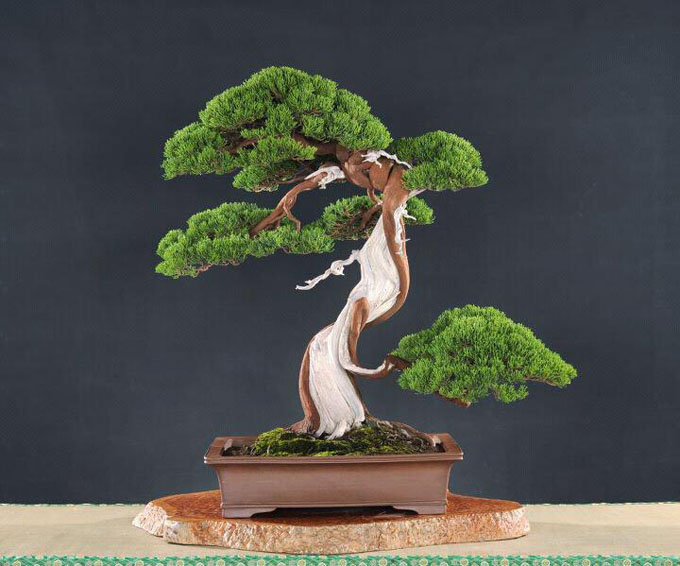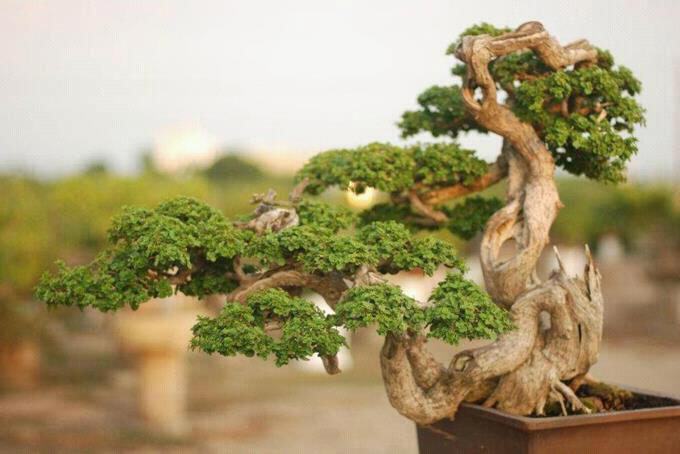 A very unusual tree. My first thought was to remove that strange first branch way down low (if you hold your hand over it, you see a remarkable bonsai with it’s powerful twisted trunk, beautiful living veins, luscious foliage and so forth). But is it that strange first branch that really distinguishes this tree?
A very unusual tree. My first thought was to remove that strange first branch way down low (if you hold your hand over it, you see a remarkable bonsai with it’s powerful twisted trunk, beautiful living veins, luscious foliage and so forth). But is it that strange first branch that really distinguishes this tree?
A facebook problem
All the trees in this post appear in a facebook photo album by Hock Lye Yap (Malaysia). It’s not clear to me that the tree’s are Hock’s. He does have a bonsai in Budi Sulistyo’s Tropical Bonsai Gallery, so we can assume he is a bonsai artist (it’s still an assumption, he could be a collector). Still, because attribution isn’t facebook’s strong point, I’m left with a question mark.
 Great tree, great pot. This tree reminds me of some of the Taiwanese bonsai we’ve featured. It would be nice to know what the caption says.
Great tree, great pot. This tree reminds me of some of the Taiwanese bonsai we’ve featured. It would be nice to know what the caption says.
 Also from Hock’s photo album.
Also from Hock’s photo album.
 This tree looks familiar. Has it already appeared in this blog? That’s not a rhetorical question, I really don’t know (and don’t want to take the time right now to try to track it down).
This tree looks familiar. Has it already appeared in this blog? That’s not a rhetorical question, I really don’t know (and don’t want to take the time right now to try to track it down).
The first one belong to Li Zhong Hong from Taiwan. He is the “Apprentice Brother” of Chen Cheng Gong”, but they have slighly different style in their bonsai design. Li is more “Chinese”…
I will be with him in Philippine in May for judging.
Thanks Robert,
That’s very helpful. I had feeling there was a Taiwan connection.
Very interesting image in the shimpaku, and food for thought. I could certainly see cutting that branch off, tilting the tree a few degrees (no more) to the right, and ta-da! But does that first branch make it what it is? Still not sure …
That last tropical tree looks “familiar” to me too. I think I’ve seen another picture of the same tree, but am not sure where.
Personally I think the lower branch actually distinguishes the whole tree from others that I have seen…….sort of like an old master doing T’ai Chi!!!!!
Hi Steve,
Yeah. I had a similar thought, but then decided that, as David Wheeler says “the lower branch actually distinguishes the whole tree from others that I have seen…”.
Hi David,
Agreed (see my other comment here).
Wayne,
Robert is partially correct. This tree was indeed created by Mr. Lee Zhong Hong from Kaohsiung, Taiwan, but belongs to Mr. Chiang Jin Cun, a famous bonsai patron and former director for the Taiwan National Bonsai Association. This tree is quite famous and was created using the Hualien Taiwan High mountain Junipers as a source of inspiration. Formerly, the top spiraling live vein was not as thick, thus revealing some delicate shari. It has grown quite a bit and that portion is no longer visible, making the top of the tree heavier than before.
Mr. Lee is considered one of the top bonsai masters in Taiwan, particularly in Jin and shari creation in juniper farm grown material (Diaoke/Sidiao). Like Cheng Cheng Kung, he is also one of the pioneers ins juniper carving art, first using screw drivers and needle nose pliers to peel fibers manually.
The second tree in the painted pot is also from Taiwan. This Hibiscus tiliaceus has won many awards in Taiwan. The poster is from the Hwa Fong (Chinese Wind) Exhibition or the National Bonsai Style Exhibition and Competition of Taiwan R.O.C..
The third tree is a Premna serratifolia (collected from the Phillipines), grafted with Premna microphylla and belongs to My Xiu Wen Ren of Tien Wei Township, Taiwan. Currently, Mr. Xiu specializes in Premna trees, all with different shapes and sizes. He is also very adept in growing mountain tangerine (Gelonium aequoreum), Celtis, Black Tiger tree (Diospyros/Maba buxifolia) and Hibiscus tiliaceus. Like Cheng Cheng Kung and Lee Zhong Hong, he is one of the founding members of the Taiwan Bonsai Creators Assoiation in 1998. On another note, the picture you feature is actually the back of the tree. And to answer your question: Yes, you have shown this tree before.
Kind regards,
Jose Luis
Wayne,
Robert is partially correct. This tree was trained by Mr. Li Zhong Hong from Kaohsiung, Taiwan, but actually belongs to Mr. Chiang Jin Cung, a famous bonsai patron and former director of the National Bonsai Association of Taiwan. This tree was trained using the Hualien Taiwan High mountain junipers as inspiration. Formerly, the spiraling live vein on the top portion was not as thick and exhibited delicate shari. the tree has grown extensively and this feature is no longer present.
The second tree in the colorful pot is a Hibiscus tiliaceus, also from Taiwan. It has won many awards and the caption you feature is a poster from the Hwa Fong (Chinese Wind)National Bonsai Style and Competition of Taiwan R.O.C.
The third tree belongs to Mr Xiu Wen Ren of Tien Wei, Taiwan. Mr Xiu is a founding member of the Taiwan Bonsai Creators Association and specializes in Premna bonsai. You featured this tree once before in this post: https://bonsaibark.com/2011/12/27/eccentric-bonsai-too-strange-or-just-strange-enough/
Thanks as always Jose. Your remarks shed abundant light on the bonsai of our Taiwanese friends.
Jose,
To add to my reply from a moment ago. Your knowledge of Taiwanese bonsai is thorough and quite impressive. I look forward to you future comments. If you have any links that you would like to share, please be my guest.
And BTW: the high quality of Taiwanese bonsai continues to amaze!
Wayne,
I head off to Taiwan thus forthcoming April. I have some sites, but they are all in Chinese. I’ll send you the links via email.
By the way, this Taiwan juniper (not shimpaku) is not yamadori, but farm grown. Like the vast mayority ( almost 100%) of all Taiwanese juniper bonsai.
Warm regards,
Jose luis
Thanks Jose,
Interesting about Taiwanese bonsai being field grown rather than collected. Are there no good trees to collect in Taiwan? Or perhaps regulations that prevent collection?
Wayne,
The species of juniper that grows in the high mountains will not survive the lower elevations where the vast majority of the bonsai enthusiasts and professionals are concentrated. Another fact is that it is illegal to collect trees from Taroko, Kenting and all other national parks. Many years ago, hibiscus, pemphis, orange jasmine and vine ficus were collected, but not any more. Some of those trees fetch high prizes. Anyhow, the Taiwanese are very advanced when it comes to cultivating field specimens, so there is no need to collect trees. I know a gentleman that currently has some nice Severina buxifolia yamadori. On another note, most ofthr collected pemphis and premna from Taiwan came originally from the Phillipines.
Kind regards,
Jose Luis